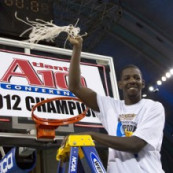Q and A with Dance Card Founder Dr. Jay Coleman
Like many others on the Bona Bandwagon we have become very interested in the website that publishes an NCAA “Dance Card,” using historical data from the selection committee to predict who gets into the field this year. As of today, this computer model thinks the Bonnies are a 100% “lock” to make the field. Clearly, this has excited a great deal of fans. I wanted to see if we could learn more about the system. We were able to do just that, as Dr. Jay Coleman, the man behind the site agreed to chat with us without hesitation. Jay breaks down his formula and provides some further insight into the website and the Bonnies chances. If you have not yet done so, be sure to check out their site here. We thank him for his time in providing such detailed and comprehensive answers to our questions.
1. Your formula essentially predicts, based on previous NCAA selection committee decisions, what teams will make the field. How many years of data does this year’s formula or system look it when deciding?
The current formula is based on analysis of selections from 1999 through 2013. However, because our research revealed somewhat different committee patterns in more recent years than in the ones prior, the current formula is based only on 2009-2013. The formula is simply applied to all current teams to get this year’s predictions.
2. St. Bonaventure, as of today, has a 100% chance of getting in according to your models. Obviously nothing is 100% certain, but does this essentially mean that in the history of your data no team with a profile similar to the Bonnies (as of today) has ever been left out of the field?
Essentially what we’re saying is that if the current committee follows the historical patterns of past committees, then the chance is 100%. (Well, no chance is fully 100%, but it’s at least 99.995%.) But committees do occasionally go completely off the rails – like with last year’s UCLA pick. That said, the committees are actually quite consistent year to year. We can only be as accurate as they are consistent, since we’re just simply modeling their past patterns. The fact that the Dance Card is very accurate is evidence of the committee’s consistency.
Also, note that all things are relative in any given year. If there happen to be a lot of teams in a given year with profiles that historically would be virtually slam dunks to get a bid, somebody has to get left out.
3. In the history of your model, what team (and year) did the computer “miss” the most? Meaning, what was the highest percent of confidence in a team that your model had in, that the selection committee left out?
I’ll answer that two ways.
The current version of the Dance Card has missed as many as three bids, which happened last year. That sounds like a lot, but the misses actually illustrated that the formula was representing committee patterns quite well. Two of the misses involved our last two teams out getting bids over our last two teams in, so those were as close as you can get. Plus, the Dance Card’s assessment of Dayton’s chances was much more accurate than most: it had the Flyers as the second team out, and they turned out to be the committee’s last team in. That they were that close to getting left out of the field shocked many – the Flyers were projected as an 8 or 9 seed by most – but not anybody paying attention to the Dance Card.
The third miss last year involved the aforementioned case of the committee going completely off its historical rails when it selected UCLA (we had UCLA with a 0.07% chance of getting a bid). When they do that, our formula is going to miss, again because it’s simply a model of the committee’s historical patterns. And the committee will sometimes do that – they’re human, plus the composition of the committee also changes year to year. We had Temple getting the bid that ultimately went to UCLA, and Temple had a bid chance of virtually 100%. So the committee selected a team with a 0.07% chance of a bid over a team with a virtually 100% chance. In recent years anyway, that’s the worst case.
4. SBU plays at St. Louis this weekend in their final regular season game. Is there a way of knowing beforehand how much the Bonnies chances would be hurt by a loss or no?
Tough to call because a lot depends on what happens with other teams around them in the ranking. But a loss hurts the RPI two ways: by hitting the Bonnies’ own winning percentage (first element of the RPI), and just playing any team with a losing record hurts the second (and most prominent) element of the RPI. Otherwise, a loss doesn’t really adversely affect other elements of the Dance Card, which are largely bonus points based on playing well against good teams.
If what happens in games elsewhere results in a past Bonnie opponent moving in or out of the top 100, that could move the needle too.
5. What’s the most shocking team you’ve seen get in as an at-large and what percent chance did the Dance Card give them before Sunday?
See the comments above about UCLA last year. NC State the previous year was rather off the rails as well, although not nearly as much as the UCLA pick. We had NC State with about a 53% chance that year.
6. Do conference tournament games hold any more weight than regular season games with the committee aside from the fact that they are neutral floor games which I know your model values greatly.
Actually, we haven’t found them to be. In fact, once you know a variety of other pieces of information, neutral floor games in general haven’t played a significant role, at least lately. We’ve also very consistently found that “hotness” down the stretch doesn’t mean anything either. So when you hear somebody quoting records in the last 10 games, last 12 games, etc., it’s irrelevant.
That said, note that conference tournament games do impact your collective conference record, and if they’re against teams in the top 25, second 25, or teams ranked 51-100, you can get bonus points for that too. They also can bump up your RPI. So they’re hardly insignificant. It’s just that they don’t necessarily hold any more weight than non-tournament games.
Categories: Editorial







More great reads
“If what happens in games elsewhere results in a past Bonnie opponent moving in or out of the top 100, that could move the needle too.”
Looking at you, Rhode Island (RPI 103). Pick up a couple wins and Bona gains another top 100 W. Buffalo and Richmond are long shots, but it would be great if one of those could get on a run and crack the 100 barrier.
Certainly, a win in St. Louis is the main thing, but I’m trying to think of a back door entry scenario in case of an emergency.